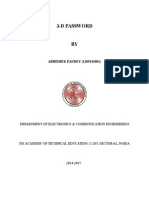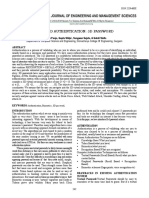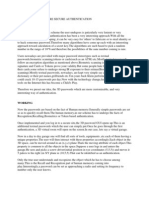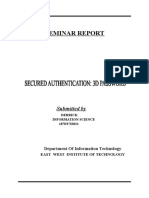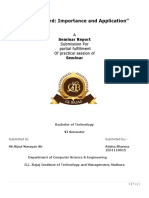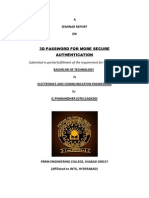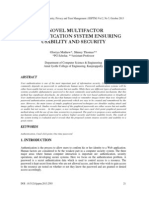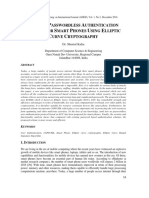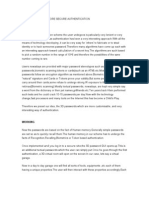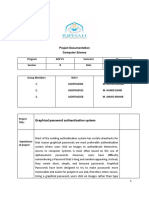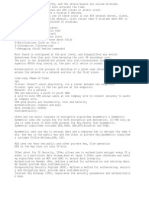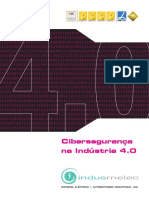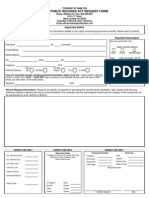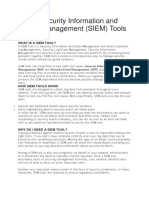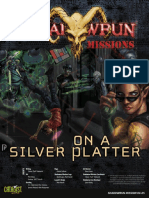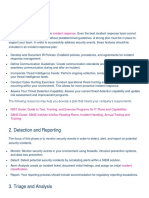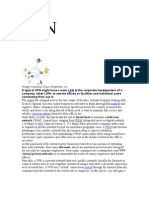Acknowledgement: 3D Password
Acknowledgement: 3D Password
Uploaded by
dreamsasiCopyright:
Available Formats
Acknowledgement: 3D Password
Acknowledgement: 3D Password
Uploaded by
dreamsasiOriginal Title
Copyright
Available Formats
Share this document
Did you find this document useful?
Is this content inappropriate?
Copyright:
Available Formats
Acknowledgement: 3D Password
Acknowledgement: 3D Password
Uploaded by
dreamsasiCopyright:
Available Formats
3D Password
Acknowledgement
3D Password
Abstract
Current authentication systems suffer from many weaknesses. Textual passwords are commonly used; however, users do not follow their requirements. Users tend to choose meaningful words from dictionaries, which make textual passwords easy to break and vulnerable to dictionary or brute force attacks. Many available graphical passwords have a password space that is less than or equal to the textual password space. Smart cards or tokens can be stolen. Many biometric authentications have been proposed; however, users tend to resist using biometrics because of their intrusiveness and the effect on their privacy. Moreover, biometrics cannot be revoked. In this paper, we present and evaluate our contribution, i.e., the 3-D password. The 3-D password is a multifactor authentication scheme. To be authenticated, we present a 3-D virtual environment where the user navigates and interacts with various objects. The sequence of actions and interactions toward the objects inside the 3-D environment constructs the users 3-D password. The 3-D password can combine most existing authentication schemes such as textual passwords, graphical passwords, and various types of biometrics into a 3D virtual environment. The design of the 3-D virtual environment and the type of objects selected determine the 3D password key space.
3D Password
Index
Introduction Authentication Biometrics Graphical passwords Multifactor Textual passwords 3-D passwords 3-D virtual environment
3D Password
Introduction
Three Basic Identification Methods of password
Possession (Something I have) Biometrics (Something I am) Knowledge (Something I know)
Password
It is basically an encryption algorithm. Usually it is 8-15 character or slightly more than that. Mostly textual passwords now a day are kept very simple say a word from the dictionary or their pet names, friends etc. Ten years back Klein performed such tests and he could crack 10-15 passwords per day. Now with the technology change, fast processors and many tools on the Internet this has become a Child's Play.
Passphrase
Its nothing but the enhance version of password.
3D Password
Usually it is a combination of words or simply collection of password in proper sequence is Passphrase. It contains any well known thought also. Length of Passphrase is about 30-50 character or more than that also. But it has also some limitations because 30-50 character is creates ambiguity to remember if there is no any proper sequence.
Biometrics
Refer to a broad range of technologies Automate the identification or verification of an individual Based on human characteristics or body organs o Physiological: Face, fingerprint, iris o Behavioral: Hand-written signature, voice Characteristics
Templates
011001010010101 011010100100110 001100010010010...
But biometrics has also some drawbacks. Suppose you select your fingerprint as a biometrics. But what to do when you have crack or wound in your finger. In this situation you might be in trouble.
3D Password
And now days some hackers even implement exact copy of your biometrics also After seeing all the different security scheme now it is time to do something advance in this security system. Here, the 3D password comes into the picture.
3D Password
3D PASSWORD
The dramatic increase of computer usage has given rise to many security concerns. One major security concern is authentication, which is the process of validating who you are to whom you claimed to be. In general, human authentication techniques can be classified as knowledge based (what you know), token based (what you have), and biometrics (what you are). Knowledge-based authentication can be further divided into two categories as follows: 1) recall based and 2) recognition based [1]. Recall-based techniques require the user to repeat or reproduce a secret that the user created before. Recognition based techniques require the user to identify and recognize the secret, or part of it, that the user selected before [1]. One of the most common recall-based authentication schemes used in the computer world is textual passwords. One major drawback of the textual password is its two conflicting requirements: the selection of passwords that are easy to remember and, at the same time, are hard to guess. Klein [2] collected the passwords of nearly 15 000 accounts that had alphanumerical passwords, and he reached the following observation: 25% of the passwords were guessed by using a small yet well-formed dictionary of 3 X 106 words. Furthermore, 21% of the passwords were guessed in the first week and 368 passwords were guessed within the first 15 min. Klein [2] stated that by looking at these results in a system with about 50 accounts, the first account can be guessed in 2 min and 515 accounts can be guessed in the first day. Klein
3D Password
[2] showed that even though the full textual password space for eight-character passwords consisting of letters and numbers is almost 2 X 1014 possible passwords, it is easy to crack 25% of the passwords by using only a small subset of the full password space. It is important to note that Kleins experiment was in 1990 when the processing capabilities, memory, networking, and other resources were very limited compared to todays technology. Many authentication systems, particularly in banking, require not only what the user knows but also what the user possesses (token-based systems). However, many reports [3][5] have shown that tokens are vulnerable to fraud, loss, or theft by using simple techniques.
Graphical passwords can be divided into two categories as follows: 1) recognition based and 2) recall based [1]. Various graphical password schemes have been proposed [6][8], [10][12]. Graphical passwords are based on the idea that users can recall and recognize pictures better than words. However, some of the graphical password schemes require a long time to be performed. Moreover, most of the graphical passwords can be easily observed or recorded while the legitimate user is performing the graphical password; thus, it is vulnerable to shoulder surfing attacks. Currently, most graphical passwords are still in their research phase and require more enhancements and usability studies to deploy them in the market. Many biometric schemes have been proposed; fingerprints, palmprints, hand geometry, face recognition, voice recognition, iris recognition, and retina recognition are all different biometric schemes. Each biometric recognition scheme has its advantages and disadvantages based on several factors such as consistency, uniqueness, and acceptability. One
3D Password
of the main drawbacks of applying biometrics is its intrusiveness upon a users personal characteristic. Moreover, retina biometrical recognition schemes require the user to willingly subject their eyes to a low-intensity infrared light. In addition, most biometric systems require a special scanning device to authenticate users, which is not applicable for remote and Internet users.
In this paper, we comprehensively analyze and discuss the 3-D password [16]. The 3-D password is a multifactor authentication scheme. It can combine all existing authentication schemes into a single 3-D virtual environment. This 3-D virtual environment contains several objects or items with which the user can interact. The type of interaction varies from one item to another. The 3-D password is constructed by observing the actions and interactions of the user and by observing the sequences of such actions. It is the users choice to select which type of authentication techniques will be part of their 3-D password. This is achieved through interacting only with the objects that acquire information that the user is comfortable in providing and ignoring the objects that request information that the user prefers not to provide. For example, if an item requests an iris scan and the user is not comfortable in providing such information, the user simply avoids interacting with that item. Moreover, giving the user the freedom of choice as to what type of authentication schemes will be part of their 3-D password and given the large number of objects and items in the environment, the number of possible 3-D passwords will increase. Thus, it becomes much more difficult for the attacker to guess the users 3-D password. The remainder of this paper is organized as follows: Section II discusses related works. Section III introduces the 3-D
3D Password
password. It also discusses the guidelines of building the 3-D virtual environment and its possible applications. Section IV discusses the security analysis, including possible attacks and countermeasures. Section V presents the experimental results. Finally, Section VI concludes and discusses future work.
RELATED WORKS
Many graphical password schemes have been proposed [6] [8], [10][12]. Blonder [6] introduced the first graphical password schema. Blonders idea of graphical passwords is that by having a predetermined image, the user can select or touch regions of the image causing the sequence and the location of the touches to construct the users graphical password. After Blonder [6], the notion of graphical passwords was developed. Many graphical password schemes have been proposed. Existing graphical passwords can be categorized into two categories as follows: 1) recall based and 2) recognition based [1]. Dhamija and Perrig [7] proposed Dj Vu, which is a Recognition-based graphical password system that authenticates Users by choosing portfolios among decoy portfolios. These portfolios are art randomized portfolios. Each image is derived from an 8-B seed. Therefore, an authentication server does not need to store the whole image; it simply needs to store the 8-B seed. Another recognitionbased graphical password is Passfaces [8]. Passfaces simply works by having the user select a subgroup of k faces from a group of n faces. For authentication, the system shows m faces and one of the faces belongs to the subgroup k. The user has to do the selection many times to complete the authentication process. Another scheme is the Story scheme [9], which requires the selection of pictures of objects (people, cars,
3D Password
foods, airplanes, sightseeing, etc.) to form a story line. Davis et al. [9] concluded that the users choices in Passfaces and in the Story scheme result in a password space that is far less than the theoretical entropy. Therefore, it leads to an insecure authentication scheme.
The graphical password schema of Blonder [6] is considered to be recall based since the user must remember selection locations. Moreover, PassPoint [10][12] is a recall-based graphical password schema, where a background picture is presented and the user is free to select any point on the picture as the users password (users PassPoint). Draw a Secret (DAS), which is a recall-based graphical password schema and introduced by Jermyn et al. [13], is simply a grid in which the user creates a drawing. The users drawings, which consist of strokes, are considered to be the users password. The size and the complexity of the grid affect the probable password space. Larger grid sizes increase the full password space. However, there are limitations in grid complexity due to human error. It becomes very hard to recall where the drawing started and ended and where the middle points were if we have very large grid sizes. One important type of authentication is based on who you are or, in other words, biometrics. Biometric recognition systems have been exhaustively studied as a way of authentication. Fingerprints, palmprints, face recognition, voice recognition, and iris and retina recognition are all different methodologies of biometric recognition systems. However, some human properties are vulnerable to change from time to time due to several reasons such as aging, scarring, face makeup, change of hairstyle, and sickness (change of voice). Moreover, people tend to resist biometrics for different reasons. Some people think that keeping a copy of the users fingerprints is not acceptable and is a threat to the users privacy. In addition,
3D Password
some users resist the idea of a low-intensity infrared light or any other kind of light directed at their eyes, such as in retina recognition systems. Moreover, biometrics cannot be revoked, which leads to a dilemma in case the users data have been forged. Unlike other authentication schemes where the user can alter his/her textual password in case of a stolen password or replace his/her token if it has been stolen or forged, a users biometrics cannot be revoked.
Many authentication systems are based on tangible objects and are referred to as token-based systems. Many token-based systems are vulnerable to theft and loss; therefore, most token based systems require a personal identification number (PIN) for authentication. The 3-D password [16] has been proposed, and initial results have been presented.
3-D PASSWORD SCHEME
In this section, we present a multifactor authentication scheme that combines the benefits of various authentication schemes. We attempted to satisfy the following requirements.
1) The new scheme should not be either recall based or Recognition based only. Instead, the scheme should be a combination of recall-, recognition-, biometrics-, and Token-based authentication schemes. 2) Users ought to have the freedom to select whether the 3-D password will be solely recall-, biometrics-, recognition-, or tokenbased, or a combination of two schemes or more. This freedom of selection is necessary because users are different and they have different requirements. Some users do not like to carry cards. Some
3D Password
users do not like to provide biometrical data, and some users have poor memories. Therefore, to ensure high user acceptability, the users freedom of selection is important. 3) The new scheme should provide secrets that are easy to remember and very difficult for intruders to guess. 4) The new scheme should provide secrets that are not easy to write down on paper. Moreover, the scheme secrets should be difficult to share with others. 5) The new scheme should provide secrets that can be easily revoked or changed. Based on the aforementioned requirements, we propose our contribution, i.e., the 3-D password authentication scheme. 3-D Password Overview
The 3-D password is a multifactor authentication scheme. The 3-D password presents a 3-D virtual environment containing various virtual objects. The user navigates through this environment and interacts with the objects. The 3-D password is simply the combination and the sequence of user interactions that occur in the 3-D virtual environment. The 3-D password can combine recognition-, recall-, token-, and biometrics-based systems into one authentication scheme. This can be done by designing a 3-D virtual environment that contains objects that request information to be recalled, information to be recognized, tokens to be presented, and biometrical data to be verified. For example, the user can enter the virtual environment and type something on a computer that exists in (x1, y1, z1) position, then enter a room that has a fingerprint recognition device that exists in a position (x2, y2,
3D Password
z2) and provide his/her fingerprint. Then, the user can go to the virtual garage, open the car door, and turn on the radio to a specific channel. The combination and the sequence of the previous actions toward the specific objects construct the users 3-D password.
Virtual objects can be any object that we encounter in real life. Any obvious actions and interactions toward the real-life objects can be done in the virtual 3-D environment toward the virtual objects. Moreover, any user input (such as speaking in a specific location) in the virtual 3-D environment can be considered as a part of the 3-D password. We can have the following objects:
1) A computer with which the user can type; 2) A fingerprint reader that requires the users fingerprint; 3) A biometrical recognition device; 4) A paper or a white board that a user can write, sign, or Draw on; 5) An automated teller machine (ATM) that requests a token; 6) A light that can be switched on/off; 7) A television or radio where channels can be selected; 8) A staple that can be punched; 9) A car that can be driven; 10) A book that can be moved from one place to another; 11) Any graphical password scheme; 12) Any real-life object; 13) Any upcoming authentication scheme.
The action toward an object (assume a fingerprint recognition device) that exists in location (x1, y1, z1) is different from the actions toward a similar object (another fingerprint recognition device) that exists in location (x2, y2, z2), where x1!= x2, y1! = y2, and z1!= z2. Therefore, to perform the legitimate 3-D password, the user must follow the same scenario performed by the legitimate user. This means interacting with the same
3D Password
objects that reside at the exact locations and perform the exact actions in the proper sequence. 3-D Password Selection and Inputs
Let us consider a 3-D virtual environment space of size G x G x G. The 3-D environment space is represented by the coordinates (x, y, z) [1, . . . , G] x [1, . . . , G] x [1, . . . , G]. The objects are distributed in the 3-D virtual environment with unique (x, y, z) coordinates. We assume that the user can navigate into the 3-D virtual environment and interact with the objects using any input device such as a mouse, keyboard, fingerprint scanner, iris scanner, stylus, card reader, and microphone. We consider the sequence of those actions and interactions using the previous input devices as the users 3-D password. For example, consider a user who navigates through the 3-D virtual environment that consists of an office and a meeting room. Let us assume that the user is in the virtual office and the user turns around to the door located in (10, 24, 91) and opens it. Then, the user closes the door. The user then finds a computer to the left, which exists in the position (4, 34, 18),And the user types FALCON. Then, the user walks to the meeting room and picks up a pen located at (10, 24, 80) and draws only one dot in a paper located in (1, 18, 30), which is the dot (x, y) coordinate relative to the paper space is (330, 130). The user then presses the login button. The initial representation of user actions in the 3-D virtual environment can be recorded as follows: (10, 24, 91) Action = Open the office door; (10, 24, 91) Action = Close the office door; (4, 34, 18) Action = Typing, F; (4, 34, 18) Action = Typing, A; (4, 34, 18) Action = Typing, L; (4, 34, 18) Action = Typing, C;
3D Password
(4, 34, 18) Action = Typing, O; (4, 34, 18) Action = Typing, N; (10, 24, 80) Action = Pick up the pen; (1, 18, 80) Action = Drawing, point = (330, 130).
This representation is only an example. The extensive real representation will not be discussed in this paper. In order for a legitimate user to be authenticated, the user has to follow the same sequence and type of actions and interactions toward the objects for the users original 3-D password. Fig. 1 shows a virtual computer that accepts textual passwords as a part of a users 3-D password. Three-dimensional virtual environments can be designed to include any virtual objects. Therefore, the first building block of the 3-D password system is to design the 3-D virtual environment and to determine what objects the environment will contain. In addition, specifying the objects properties is part of the system design. The design of the 3-D virtual environment influences the overall password space, usability, and performance of the 3-D password system. Fig. 2 shows a snapshot of an experimental 3-D virtual environment.
3D Password
Fig.1. Snapshot of a proof-of-concept 3-D virtual environment, where the user is typing a textual password on a virtual computer as a part of the users 3-D password.
Fig.2. Snapshot of a proof-of-concept virtual art gallery, which contains 36 pictures and six computers
3D Password
To simplify the idea of how a 3-D password works, Fig. 3 shows a state diagram of a possible 3-D password authentication system.
3-D Virtual Environment Design Guidelines
Designing a well-studied 3-D virtual environment affects the usability, effectiveness, and acceptability of a 3-D password system. Therefore, the first step in building a 3-D password system is to design a 3-D environment that reflects the administration needs and the security requirements. The design of 3-D virtual environments should follow these guidelines.
1) Real-life similarity: The prospective 3-D virtual environment should reflect what people are used to seeing in real life. Objects used in virtual environments should be relatively similar in size to real objects (sized to scale). Possible actions and interactions toward virtual objects should reflect real-life situations. Object responses should be realistic. The target should have a 3-D virtual environment that users can interact with, by using common sense. 2) Object uniqueness and distinction: Every virtual object or item in the 3-D virtual environment is different from any other virtual object. The uniqueness comes from the fact that every virtual object has its own attributes such as position. Thus, the prospective interaction with object 1 is not equal to the interaction with object 2. However, having similar objects such as 20 computers in one place might confuse the user. Therefore, the design of the 3-D virtual environment should consider that every object should be distinguishable from other objects. A simple real-life example is home numbering. Assume that there are 20 or more homes that look like each other and the homes are not numbered. It would be difficult to distinguish which house was visited a month ago. Similarly, in designing a 3-D virtual environment, it should be easy
3D Password
for users to navigate through and to distinguish between objects. The distinguishing factor increases the users recognition of objects. Therefore, it improves the system usability. 3) Three-dimensional virtual environment size: A 3-D virtual environment can depict a city or even the world. On the other hand, it can depict a space as focused as a single room or office. The size of a 3-D environment should be carefully studied. A large 3-D virtual environment will increase the time required by the user to perform a 3-D password. Moreover, a large 3-D virtual environment can contain a large number of virtual objects. Therefore, the probable 3-D password space broadens. However, a small 3-D virtual environment usually contains only a few objects, and thus, performing a 3-D password will take less time. 4) Number of objects (items) and their types: Part of designing a 3D virtual environment is determining the types of objects and how many objects should be placed in the environment. The types of objects reflect what kind of responses the object will have. For simplicity, we can consider requesting a textual password or a fingerprint as an object response type. Selecting the right object response types and the number of objects affects the probable password space of a 3-D password. 5) System importance: The 3-D virtual environment should consider what systems will be protected by a 3-D password. The number of objects and the types of objects that have been used in the 3-D virtual environment should reflect the importance of the protected system. 3-D Password Applications
Because a 3-D password can have a password space that is very large compared to other authentication schemes, the 3-D passwords main application domains are protecting critical
3D Password
systems and resources. Possible critical applications include the following.
Fig.3. State diagram of a possible 3-D password application
1) Critical servers: Many large organizations have critical servers that are usually protected by a textual password. A 3-D password authentication proposes a sound replacement for a textual password. Moreover, entrances to such locations are usually protected by access cards and sometimes PIN numbers. Therefore, a 3-D password can be used to protect the entrance to such locations and protect the usage of such servers.
3D Password
2) Nuclear and military facilities: Such facilities should be protected by the most powerful authentication systems. The 3-D password has a very large probable password space, and since it can contain token-, biometrics-, recognition-, and knowledge-based authentications in a single authentication system, it is a sound choice for high level security locations. 3) Airplanes and jetfighters: Because of the possible threat of misusing airplanes and jetfighters for religion-political agendas, usage of such airplanes should be protected by a powerful authentication system. The 3-D password is recommended for these systems.
In addition, 3-D passwords can be used in less critical systems because the 3-D virtual environment can be designed to fit any systems needs. A small 3-D virtual environment can be used in many systems, including the following:
1) ATMs; 2) Personal digital assistants; 3) Desktop computers and laptop logins; 4) Web authentication.
SECURITY ANALYSIS
To analyze and study how secure a system is, we have to consider how hard it is for the attacker to break such a system. A possible measurement is based on the information content of a password space, which is defined in [13] as the entropy of the probability distribution over that space given by the relative frequencies of the passwords that users actually choose. We have seen that textual password space may be relatively large; however, an attacker might only need a small subset of the full password space as Klein [2] observed to
3D Password
successfully break such an authentication system. As a result, it is important to have a scheme that has a very large possible password space as one factor for increasing the work required by the attacker to break the authentication system. Another factor is to find a scheme that has no previous or existing knowledge of the most probable user password selection, which can also resist the attack on such an authentication scheme.
In Section IV-A, we will discuss the size of the 3-D password space. Then, we will study the knowledge distribution of the 3-D password. Afterward, we will analyze the possible attacks on the 3-D password.
Fig.4 Password space of the 3-D password, textual password, Passfaces, and DAS with grid sizes of 5 5 and 10 10. Length is the number of actions and interactions for a 3-D password, the number of characters for textual passwords, the number of selections for Passfaces, and the number of points that represent the strokes for DAS. The length is up to eight
3D Password
(characters/actions, interactions, inputs/selections). The 3-D password virtual environment is as specified in Section V-A; bit size is the log2 of the entire probable password space.
3-D Password Space Size
One important factor to determine how difficult it is to launch an attack on an authentication system is the size of the password space. To determine the 3-D password space, we have to count all possible 3-D passwords that have a certain number of actions, interactions, and inputs toward all objects that exist in the 3-D virtual environment. We assume that the length of the 3-D password is Lmax, and the probability of the 3-D password of size greater than Lmax is zero. To measure the 3-D password space, we will calculate (Lmax, G) on a 3-D virtual environment that has the space (G x G x G) for a 3-D password of a length (number of actions, interactions, and inputs) of Lmax or less. In the following expression, AC represents the possible actions toward the 3-D virtual environment, whereas represents the total numbers of possible 3-D passwords of length Lmax or less:
In the following expression (2), Omax is the number of objects in the 3-D virtual environment:
3D Password
Where xi = xj, yi = yj, and zi = zj, only if i = j. The design of the 3-D environment will determine the value of Omax. The variable m represents all possible actions and interactions toward all existing objects Oi. However, g(AC) counts the total number of actions and inputs toward the 3-D virtual environment, whereas m, as we mentioned before, counts the actions and interactions toward the objects. An example of g(AC) can be a user movement pattern, which can be considered as a part of the users 3-D password. The function is the number of possible actions and interactions toward the object Oi based on the object type Ti. Object types can be textual password objects, DAS objects, or any authentication scheme.
The function f is determined from the object type. It counts the possible actions and interactions that the object can accept. If we assume that an object Keyboard is in location (x0, y0, z0) of type = textual password, f will count the possible characters and numbers that can be typed, which is around 93 possibilities. As we mentioned before, an object type is one of the important factors that affects the overall password space. Therefore, higher outcomes of function f mean larger 3Dpassword space size. From the previous equations, we observe that the number of objects and the type of actions and interactions determines the probable password space. Therefore, the design of the 3-D virtual environment is a very critical part of the 3-D password system. Figs. 4 and 5 illustrate the resulting password space of the proposed 3-D password compared to textual password, Passfaces, and DAS of a grid of 5 x 5 and 10 x 10,
3D Password
respectively. Notice the difference between a 3-D passwords built on a simple 3-D virtual environment compared to the other authentication schemes.
Fig. 5 Password space of the 3-D password, textual password, Passfaces, and DAS with grid sizes of 5 5 and 10 10. Length is the number of actions and interactions for a 3-D password, the number of characters for textual passwords, the number of selections for Passfaces, and the number of points that represent the strokes for DAS. The length is up to eight (characters/actions, interactions, inputs/selections). The 3-D password virtual environment is as specified in Section V-A; bit size is the log2 of the entire probable password space.
3D Password
Fig. 6 observing the number of possible actions/interactions of a 3-D password within a 3-D environment specified in Section V-A compared to the two critical points of textual passwords. Point a is the bit size of Klein [2] (3 106) dictionary of eight-character textual passwords. Point b represents the full password space of eight-character textual passwords.
Fig. 6 shows the points where the 3-D password exceeds two important textual password points. Point a shows that by having only two actions and interactions as a 3-D password, the 3-D password exceeds the number of textual passwords used by Klein [2] to break 25% of textual passwords of eight characters. Point b represents the full textual password space of eight characters or less. It shows that by performing only four interactions, actions, and inputs as a 3-D password, the 3D password space exceeds the full textual passwords of eight characters or less.
3D Password
3-D Password Distribution Knowledge
Studying the users behavior of password selection and knowing the most probable textual passwords are the key behind dictionary attacks. Klein [2] used such knowledge to collect a small set of 3 x 106 words that have a high probability of usage among users. The question is how has such information (highly probable passwords) been found and why. Users tend to choose words that have meaning, such as places, names, famous peoples names, sports terms, and biological terminologies. Therefore, finding these different words from the dictionary is a relatively simple task. Using such knowledge yields a high success rate for breaking textual passwords. Any authentication scheme is affected by the knowledge distribution of the users secrets. According to Davis et al. [9], Passfaces [8] users tend to choose faces that reflect their own taste on facial attractiveness, race, and gender. Moreover, 10% of male passwords have been guessed in only two guesses. Another study [14] about user selection of DAS [13] concluded that for their secret passwords, users tend to draw things that have Meaning, which simplifies the attackers task. Currently, knowledge about user behaviors on selecting their 3-D password does not exist. Every user has different requirements and preferences when selecting the appropriate 3-D password. This fact will increase the effort required to find a pattern of users highly selected 3-D password. In addition, since the 3-D password combines several authentication schemes into a single authentication environment, the attacker has to study every single authentication scheme and has to discover what the most probable selected secrets are. For textual password, the highly probable selected textual password might be determined by the
3D Password
use of dictionaries. However, there are many authentication schemes with undiscovered probable password space.
Since every 3-D password system can be designed according to the protected system requirements, the attacker has to separately study every 3-D password system. This is because objects that exist in one 3-D password system might not exist on other 3-D password systems. Therefore, more effort is required to build the knowledge of most probable 3-D passwords.
Attacks and Countermeasures
To realize and understand how far an authentication scheme is secure, we have to consider all possible attack methods. We have to study whether the authentication scheme proposed is immune against such attacks or not. Moreover, if the proposed authentication scheme is not immune, we then have to find the countermeasures that prevent such attacks. In this section, we try to cover most possible attacks and whether the attack is valid or not. Moreover, we try to propose countermeasures for such attacks. Brute Force Attack: The attacker has to try all possible 3-D passwords. This kind of attack is very difficult for the following reasons.
1) Time required to login: The total time needed for a legitimate user to login may vary from 20 s to 2 min or more, depending on the number of interactions and actions, the size of the 3-D virtual environment, and the type of actions and interactions done by the user as a 3-D password. Therefore, a brute force attack on a 3-D password is very difficult and time consuming.
3D Password
2) Cost of attacks: In a 3-D virtual environment that contains biometric recognition objects and token-based objects, the attacker has to forge all possible biometric information and forge all the required tokens. The cost of forging such information is very high; therefore, cracking the 3-D password is more challenging. Moreover, the high number of possible 3-D password spaces (as shown in Table I) leaves the attacker with almost no chance of breaking the 3-D password. Well-Studied Attack: The attacker tries to find the highest probable distribution of 3-D passwords. However, to launch such an attack, the attacker has to acquire knowledge of the most probable 3-D password distributions. Acquiring such knowledge is very difficult because the attacker has to study all the existing authentication schemes that are used in the 3-D environment. Moreover, acquiring such knowledge may require forging all existing biometrical data and may require forging token-based data. In addition, it requires a study of the users selection of objects, or a combination of objects, that the user will use as a 3-D password. Moreover, a well-studied attack is very hard to accomplish since the attacker has to perform a customized attack for every different 3-D virtual environment design. Every system can be protected by a 3-D password that is based on a unique 3-D virtual environment. This environment has a number of objects and types of object responses that differ from any other 3-D virtual environment. Therefore, a carefully customized study is required to initialize an effective attack.
TABLE I
3D Password
RESULTING NUMBER OF POSSIBLE 3-D PASSWORDS OF TOTAL LENGTH Lmax IN A 3-D VIRTUAL ENVIRONMENT AS SPECIFIED IN SECTION V-A
3D Password
Shoulder Surfing Attack: An attacker uses a camera to record the users 3-D password or tries to watch the legitimate user while the 3-D password is being performed. This attack is the most successful type of attack against 3-D passwords and some other graphical passwords. However, the users 3-D password may contain biometrical data or textual passwords that cannot be seen from behind. The attacker may be required to take additional measures to break the legitimate users 3-D password. Therefore, we assume that the 3-D password should be performed in a secure place where a shoulder surfing attack cannot be performed. Timing Attack: In this attack, the attacker observes how long it takes the legitimate user to perform a correct sign-in using the 3-D password. This observation gives the attacker an indication of the legitimate users 3-D password length. However, this kind of attack alone cannot be very successful since it gives the attacker mere hints. Therefore, it would probably be launched as part of a wellstudied or brute force attack. Timing attacks can be very effective if the 3-D virtual environment is poorly designed.
EXPERIMENTAL RESULTS
We have built an experimental 3-D virtual environment that contains several objects of two types. The first type of response is the textual password. The second type of response is requesting graphical passwords. Almost 30 users volunteered to experiment with the environment. We asked the users to create their 3-D password and to sign-in using their 3D password several times over several days.
>>Experimental Virtual 3-D Environment
In our experiment, we have used Java Open GL to build the 3D virtual environment and we have used a 1.80-GHz Pentium
3D Password
M Centrino machine with 512-MB random access memory and ATI Mobility Radeon 9600 video card.
The design of the experimental 3-D virtual environment represents an art gallery that the user can walk through and is depicted in Fig. 2.
>>User Study
We conducted a user study on 3-D passwords using the experimental 3-D virtual environments. The study reviewed the usage of textual passwords and other authentication schemes. The study covered almost 30 users. The users varied in age, sex, and education level. Even though it is a small set of users, the study produced some distinct results [13], [15]. We observed the following regarding textual passwords, 3-D passwords, and other authentication schemes.
1) Most users who use textual passwords of 912 character lengths or who use random characters as a password have only one to three unique passwords. 2) More than 50% of users textual passwords are eight characters or less. 3) Almost 25% of users use meaningful words as their textual passwords. 4) Almost 75% of users use meaningful words or partially meaningful words as their textual passwords. In contrast, only 25% of users use random characters and letters as textual passwords. 5) Over 40% of users have only one to three unique textual passwords, and over 90% of users have eight unique textual passwords or less.
3D Password
6) Over 90% of users do not change their textual passwords unless they are required to by the system. 7) Over 95% of users under study have never used any graphical password scheme as a means of authentication. 8) Most users feel that 3-D passwords have a high acceptability. 9) Most users believe that there is no threat to personal privacy by using a 3-D password as an authentication scheme.
CONCLUSION AND FUTURE WORK
There are many authentication schemes in the current state. Some of them are based on users physical and behavioral properties, and some other authentication schemes are based on users knowledge such as textual and graphical passwords. Moreover, there are some other important authentication schemes that are based on what you have, such as smart cards. Among the various authentication schemes, textual password and token-based schemes, or the combination of both, are commonly applied. However, as mentioned before, both authentication schemes are vulnerable to certain attacks. Moreover, there are many authentication schemes that are currently under study and they may require additional time and effort to be applicable for commercial use. The 3-D password is a multifactor authentication scheme that combines these various authentication schemes into a single 3D virtual environment. The virtual environment can contain any existing authentication scheme or even any upcoming authentication schemes by adding it as a response to actions performed on an object. Therefore, the resulted password
3D Password
space becomes very large compared to any existing authentication schemes. The design of the 3-D virtual environment, the selections of objects inside the environment, and the objects type reflect the resulted password space. It is the task of the system administrator to design the environment and to select the appropriate object that reflects the protected system requirements. Additionally, designing a simple and easy to use 3-D virtual environment is a factor that leads to a higher user acceptability of a 3-D password system. The choice of what authentication schemes will be part of the users 3-D password reflects the users preferences and requirements. A user who prefers to remember and recall a password might choose textual and graphical passwords as part of their 3-D password. On the other hand, users who have more difficulty with memory or recall might prefer to choose smart cards or biometrics as part of their 3-D password. Moreover, users who prefer to keep any kind of biometrical data private might not interact with objects that require biometric information. Therefore, it is the users choice and decision to construct the desired and preferred 3-D password. The 3-D password is still in its early stages. Designing various kinds of 3-D virtual environments, deciding on password spaces, and interpreting user feedback and experiences from such environments will result in enhancing and improving the user experience of the 3-D password. Moreover, gathering attackers from different backgrounds to break the system is one of the future works that will lead to system improvement and prove the complexity of breaking a 3-D password. Moreover, it will demonstrate how the attackers will acquire the knowledge of the most probable 3-D passwords to launch their attacks.
3D Password
Shoulder surfing attacks are still possible and effective against 3-D passwords. Therefore, a proper solution is a field of research.
You might also like
- AZURE AZ 500 STUDY GUIDE-1: Microsoft Certified Associate Azure Security Engineer: Exam-AZ 500From EverandAZURE AZ 500 STUDY GUIDE-1: Microsoft Certified Associate Azure Security Engineer: Exam-AZ 500No ratings yet
- 3D Password Seminar ReportDocument5 pages3D Password Seminar ReportNATIONAL XEROX100% (1)
- Advances in Cryptology - EUROCRYPT 2009Document622 pagesAdvances in Cryptology - EUROCRYPT 2009Ta Thanh DinhNo ratings yet
- Acknowledgement: 3D PasswordDocument37 pagesAcknowledgement: 3D PasswordMuthu SelvamNo ratings yet
- 3 DPSWDDocument25 pages3 DPSWDpadikalagopichandNo ratings yet
- 3d Password Seminar ReportDocument35 pages3d Password Seminar ReportAakash Kumar SinhaNo ratings yet
- Department of Computer Science & Engineering, VVITDocument27 pagesDepartment of Computer Science & Engineering, VVITrajkumar mikkilkiNo ratings yet
- Submitted By: Name: S.Vaishnavi@ Bhavani Class: II M.SC (CS & IT) Roll - No: BPN10Document20 pagesSubmitted By: Name: S.Vaishnavi@ Bhavani Class: II M.SC (CS & IT) Roll - No: BPN10Vaishu SadhaNo ratings yet
- Seminar Report'10 3-D PasswordDocument22 pagesSeminar Report'10 3-D Passwordthulasi1991No ratings yet
- 3-D Password: ABHISHEK PANDEY (1209141001)Document34 pages3-D Password: ABHISHEK PANDEY (1209141001)Abhishek PandeyNo ratings yet
- 3D Password Modern Approach To Security: AbstractDocument8 pages3D Password Modern Approach To Security: AbstractSujith saNo ratings yet
- 3d PasswordDocument28 pages3d PasswordAmar PandaNo ratings yet
- Secured Authentication: 3D PasswordDocument4 pagesSecured Authentication: 3D PasswordLEESHMANo ratings yet
- MIC College of Technology: Technical Seminar ReportDocument13 pagesMIC College of Technology: Technical Seminar ReportSarat PendelaNo ratings yet
- Smart CardsDocument1 pageSmart CardsNandu ShriNo ratings yet
- 3d Seminar ReportDocument19 pages3d Seminar ReportYudi19100% (1)
- A Review On Secured Authentication Using 3D Password: M. Padmaja P.ManjulaDocument6 pagesA Review On Secured Authentication Using 3D Password: M. Padmaja P.ManjulaEditor InsideJournalsNo ratings yet
- 29 Ijmtst0802099Document5 pages29 Ijmtst0802099Akshay JadhavNo ratings yet
- SemiDocument14 pagesSemishanuhardikNo ratings yet
- 3d SeminarDocument11 pages3d SeminarAfroz HnyNo ratings yet
- ORGINALDocument29 pagesORGINALSrinivas Chowdary DirisalaNo ratings yet
- Secured AuthenticationDocument9 pagesSecured AuthenticationAmutha ArunNo ratings yet
- 3d Password For More Secure AuthenticationDocument12 pages3d Password For More Secure AuthenticationYojana ReddyNo ratings yet
- Ijs DR 1904006Document6 pagesIjs DR 1904006Shubham SagarNo ratings yet
- 7 VI June 2019Document6 pages7 VI June 2019Shubham SagarNo ratings yet
- 3d PasswordDocument18 pages3d Passwordsuriya rashmiNo ratings yet
- Seminar Report: Submitted byDocument29 pagesSeminar Report: Submitted byNeha Vinod Holamoge80% (5)
- More Secured Authentication 3d Password IJERTCONV3IS10042Document5 pagesMore Secured Authentication 3d Password IJERTCONV3IS10042Shubham SagarNo ratings yet
- 3dpwd AlsulaimanDocument11 pages3dpwd AlsulaimanShubham SagarNo ratings yet
- 3d PasswordDocument17 pages3d PasswordRamchandra Singh100% (1)
- Advance Authentication Technique: 3D Password: Pooja M. Shelke F. M. Shelke Mr. B. G. PundDocument4 pagesAdvance Authentication Technique: 3D Password: Pooja M. Shelke F. M. Shelke Mr. B. G. PundEditor IJRITCCNo ratings yet
- 1110 3844 PDFDocument10 pages1110 3844 PDFbusybeeNo ratings yet
- Literature Review of 3d PasswordDocument7 pagesLiterature Review of 3d Passwordafmzvadopepwrb100% (1)
- 3 D PasswordDocument21 pages3 D PasswordAtisha SharmaNo ratings yet
- 3d Password For More Secure AuthenticationDocument7 pages3d Password For More Secure AuthenticationRukshana MeeranNo ratings yet
- 3d PasswordDocument1 page3d Passwordkrishna4143No ratings yet
- SEMINAR Phase OneDocument14 pagesSEMINAR Phase Onegadisa gemechuNo ratings yet
- Igjerv90105 (1) - 220731 - 104251 PDFDocument6 pagesIgjerv90105 (1) - 220731 - 104251 PDFתומר שרהבניNo ratings yet
- 3D Password: Minimal Utilization OF Space AND Vast Security Coupled With Biometrics FOR Secure AuthenticationDocument7 pages3D Password: Minimal Utilization OF Space AND Vast Security Coupled With Biometrics FOR Secure AuthenticationArunChirappurathNo ratings yet
- Graphical Password Authentication SystemDocument9 pagesGraphical Password Authentication SystemIJRASETPublicationsNo ratings yet
- Three Dimensional Password For More Secure Authentication: Name: Manila M V ROLL NO: CS08M028Document2 pagesThree Dimensional Password For More Secure Authentication: Name: Manila M V ROLL NO: CS08M028swaroopjainNo ratings yet
- Documentation 3d PasswordDocument23 pagesDocumentation 3d PasswordSiligam Pranitha100% (2)
- A Technical Seminar OnDocument6 pagesA Technical Seminar OnRavikryitNo ratings yet
- 3D Passwords Table of Contents: TitleDocument14 pages3D Passwords Table of Contents: TitleArathy VikramNo ratings yet
- Autheticatio N Knowled Ge Based Recall (Textual) Recogniti ON (Graphica L) Token Based BiometricDocument2 pagesAutheticatio N Knowled Ge Based Recall (Textual) Recogniti ON (Graphica L) Token Based BiometricPrashant KumarNo ratings yet
- IEEE: A Novel 3D Graphical Password SchemaDocument4 pagesIEEE: A Novel 3D Graphical Password SchemaMayur KashyapNo ratings yet
- IEEE: A Novel 3D Graphical Password SchemaDocument4 pagesIEEE: A Novel 3D Graphical Password SchemaMD BIKASH SKNo ratings yet
- 3-D Password: For More Secure AuthenticationDocument20 pages3-D Password: For More Secure AuthenticationVineet GuptaNo ratings yet
- A Novel 3D Graphical Password Schema: Fawaz A Alsulaiman and Abdulmotaleb El SaddikDocument4 pagesA Novel 3D Graphical Password Schema: Fawaz A Alsulaiman and Abdulmotaleb El SaddikSudhanshu KumarNo ratings yet
- A Novel Multifactor PDFDocument10 pagesA Novel Multifactor PDFijsptmNo ratings yet
- 3D Password PptsDocument22 pages3D Password PptsVidhya ChouguleNo ratings yet
- Advanced Authentication Using 3D Passwords in Virtual World: Nisha Salian, Sayali Godbole, Shalaka WaghDocument6 pagesAdvanced Authentication Using 3D Passwords in Virtual World: Nisha Salian, Sayali Godbole, Shalaka WagherpublicationNo ratings yet
- Application of Graphical Password As KnoDocument9 pagesApplication of Graphical Password As KnoLemuel KohNo ratings yet
- Maharana Pratap College of Technology: Seminar On: 3D PASSWORD CS 507Document22 pagesMaharana Pratap College of Technology: Seminar On: 3D PASSWORD CS 507sd2808No ratings yet
- Graphical Password Authentication SystemDocument16 pagesGraphical Password Authentication SystemAngamuthuNo ratings yet
- A Novel Passwordless Authentication Sche PDFDocument17 pagesA Novel Passwordless Authentication Sche PDFraveendrababupNo ratings yet
- 3d Password For More Secure AuthenticationDocument6 pages3d Password For More Secure AuthenticationManju Rose DwaraiNo ratings yet
- Graphical PWD AuthDocument10 pagesGraphical PWD AuthMonale AlexNo ratings yet
- Assignment 2 Project1Document5 pagesAssignment 2 Project1M.Bilal JattNo ratings yet
- Authentication Techniques For Engendering Session Passwords With Colors and TextDocument8 pagesAuthentication Techniques For Engendering Session Passwords With Colors and TextGanesh NkNo ratings yet
- Information SecurityDocument72 pagesInformation SecurityDeepika SharmaNo ratings yet
- John W Schaum Piano Course A The Red Book - SeowsmiDocument2 pagesJohn W Schaum Piano Course A The Red Book - Seowsmisumit0% (1)
- Cisco CCNA CommandsDocument5 pagesCisco CCNA CommandsDaniel Benavides ONo ratings yet
- Useful Java Hints For Programming Competitions: Bryce Kerley October 13, 2005Document8 pagesUseful Java Hints For Programming Competitions: Bryce Kerley October 13, 2005Elavarasan ThaNo ratings yet
- Ccna NotesDocument2 pagesCcna NotesAhmad AliNo ratings yet
- Cibersegurança Na Indústria 4.0Document10 pagesCibersegurança Na Indústria 4.0Nuno HenriquesNo ratings yet
- Impact of Storage Devices On The EnviromentDocument4 pagesImpact of Storage Devices On The Enviromentalfredsamsele2100% (1)
- Hamilton Township (Atlantic County) OPRA FormDocument4 pagesHamilton Township (Atlantic County) OPRA FormThe Citizens CampaignNo ratings yet
- 8 Best SIEM SolutionsDocument10 pages8 Best SIEM SolutionsJag GeronimoNo ratings yet
- Evolution of Cyber CrimesDocument43 pagesEvolution of Cyber Crimesarleen_capricon8839100% (2)
- AVCS Tokyo Keiki 8x00 S63!1!1 User GuideDocument29 pagesAVCS Tokyo Keiki 8x00 S63!1!1 User GuideLyubomir LazarovNo ratings yet
- Stream Cipher Vs Block CipherDocument1 pageStream Cipher Vs Block CipherRohini muruganNo ratings yet
- Application Form For IT AssitDocument1 pageApplication Form For IT AssitDeepak SharmaNo ratings yet
- PrecedentialDocument35 pagesPrecedentialScribd Government DocsNo ratings yet
- SRM04-05 On A Silver PlatterDocument37 pagesSRM04-05 On A Silver PlatterBrandon Dempe100% (3)
- Matrices Example With MathematicaDocument11 pagesMatrices Example With MathematicaBogdan TanasoiuNo ratings yet
- Theft-Detection Using Motion Sensing Camera: IJISRT17NV31Document8 pagesTheft-Detection Using Motion Sensing Camera: IJISRT17NV31International Journal of Innovative Science and Research TechnologyNo ratings yet
- FBI Complaint US Attorneys Office CorruptionDocument4 pagesFBI Complaint US Attorneys Office CorruptionBilly Earley100% (1)
- Nism Admit CardDocument2 pagesNism Admit Cardsuresh sunnyNo ratings yet
- Disaster Recovery Procedures Manual SampleDocument3 pagesDisaster Recovery Procedures Manual Sampleresurse0% (1)
- Blackberry Application Developer Guide Volume 2Document188 pagesBlackberry Application Developer Guide Volume 2Diego Gimenes100% (1)
- Incident Response ProcessDocument3 pagesIncident Response ProcessJohn JacobsNo ratings yet
- Myntra Terms of UseDocument8 pagesMyntra Terms of UseNimalanNo ratings yet
- Data Security and PrivacyDocument14 pagesData Security and Privacychaaru lathaNo ratings yet
- VPNDocument4 pagesVPNmohdevrajNo ratings yet
- Best Practices in Cybercrime Investigation in The Republic of KoreaDocument7 pagesBest Practices in Cybercrime Investigation in The Republic of KoreaNabeel AbdullaNo ratings yet
- Theory and Practice of Flash Memory Mobile Forensics PDFDocument33 pagesTheory and Practice of Flash Memory Mobile Forensics PDFraid87No ratings yet
- NEW REVISED - Supplementary File 5 - Tutorial MCMCGLMMDocument22 pagesNEW REVISED - Supplementary File 5 - Tutorial MCMCGLMMMegan KennedyNo ratings yet
- Great HackersDocument5 pagesGreat Hackersaporvearyan123No ratings yet









